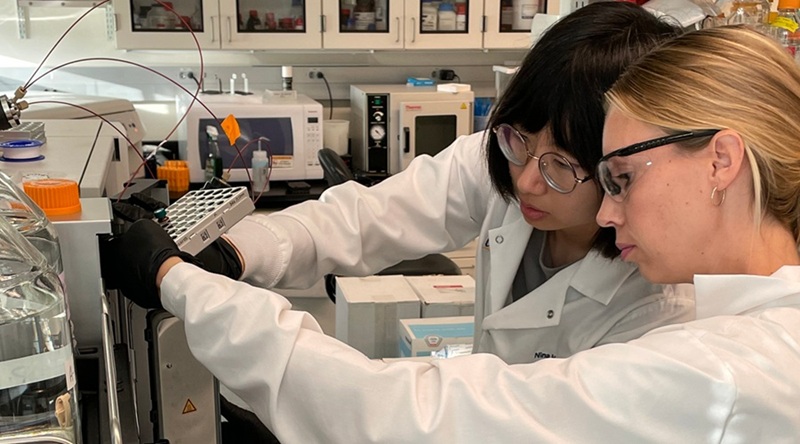Non-Invasive Imaging Detects Cancer at Molecular Level
|
By LabMedica International staff writers Posted on 20 Aug 2019 |

Image: Scientists combined multiphoton microscopy with automated image and statistical analysis algorithms to distinguish between healthy and diseased tissue. In this image, collected in a completely label-free, noninvasive manner, collagen is colored green while ovarian metastatic cell clusters are presented in red (Photo courtesy of Tufts University).
For cancer patients the presence of metastases dictates the staging assessment, which in turn defines the appropriate treatment path selected. For gynecological malignancies, like ovarian carcinoma, it is of immense importance to differentiate between localized and metastatic disease status as that drastically affects management.
For in situ, real time diagnosis, novel imaging modalities that offer metabolic and structural information at the cellular and subcellular level can be of great help, especially since these modalities are being progressively incorporated in probes and micro-endoscopes that allow intra-vital access to organs that lie deeper in the body.
Biomedical scientists at Tufts University (Medford, MA, USA) and their colleagues collected samples from eight patients who underwent open laparotomy as part of routine medical care. Post completion of all intra-abdominal procedures of the operation, eight biopsies of healthy parietal peritoneum and if present of four peritoneal metastases were collected from each patient. All lesions were evaluated by a pathologist using standard hematoxylin and eosin histology.
The tissues were imaged employing a multiphoton laser scanning microscope to generate intrinsic fluorescence and second harmonic generation (SHG) images at 755 nm and 900 nm excitation respectively with signal emission collected at 460 ± 20 and 525 ± 25 nm. Laser light was focused on the sample using a 25x objective (0.9 NA / water-immersion), and neutral density filters were employed to achieve a power of 25–35 mW. At least two to three random fields per tissue were evaluated, reaching a total of 30 and 11 images for the healthy and metastatic biopsy tissue groups, respectively (512 × 512 pixels; 600-micron field of view; resolution of 1.17 microns per pixel). Imaging was focused within a depth of ∼20-100 microns from the mesothelial surface of the tissues.
The team found that healthy tissues displayed large variations in contrast and correlation features as a function of distance, corresponding to repetitive, increased local intensity fluctuations. Metastatic tissue images exhibited decreased contrast and correlation related values, representing more uniform intensity patterns and smaller fibers, indicating the destruction of the healthy stroma by the cancerous infiltration. Analyzing 41 images acquired from the biopsies, the technique correctly classified 40 out of 41 images (an accuracy of 97.5%). A total of 11 samples were correctly classified as metastatic (100% sensitivity) and 29 of 30 were correctly classified as healthy (96.6% specificity).
Dimitra Pouli, MD, PhD, a Pathology Resident and co-author of the study, said, “The method utilized in this work identifies in a completely label-free manner cellular and tissue features at the microscopic level, essentially acting like a biopsy without a knife,” The study was published in the August 2019 issue of the journal Biomedical Optics Express.
Related Links:
Tufts University
For in situ, real time diagnosis, novel imaging modalities that offer metabolic and structural information at the cellular and subcellular level can be of great help, especially since these modalities are being progressively incorporated in probes and micro-endoscopes that allow intra-vital access to organs that lie deeper in the body.
Biomedical scientists at Tufts University (Medford, MA, USA) and their colleagues collected samples from eight patients who underwent open laparotomy as part of routine medical care. Post completion of all intra-abdominal procedures of the operation, eight biopsies of healthy parietal peritoneum and if present of four peritoneal metastases were collected from each patient. All lesions were evaluated by a pathologist using standard hematoxylin and eosin histology.
The tissues were imaged employing a multiphoton laser scanning microscope to generate intrinsic fluorescence and second harmonic generation (SHG) images at 755 nm and 900 nm excitation respectively with signal emission collected at 460 ± 20 and 525 ± 25 nm. Laser light was focused on the sample using a 25x objective (0.9 NA / water-immersion), and neutral density filters were employed to achieve a power of 25–35 mW. At least two to three random fields per tissue were evaluated, reaching a total of 30 and 11 images for the healthy and metastatic biopsy tissue groups, respectively (512 × 512 pixels; 600-micron field of view; resolution of 1.17 microns per pixel). Imaging was focused within a depth of ∼20-100 microns from the mesothelial surface of the tissues.
The team found that healthy tissues displayed large variations in contrast and correlation features as a function of distance, corresponding to repetitive, increased local intensity fluctuations. Metastatic tissue images exhibited decreased contrast and correlation related values, representing more uniform intensity patterns and smaller fibers, indicating the destruction of the healthy stroma by the cancerous infiltration. Analyzing 41 images acquired from the biopsies, the technique correctly classified 40 out of 41 images (an accuracy of 97.5%). A total of 11 samples were correctly classified as metastatic (100% sensitivity) and 29 of 30 were correctly classified as healthy (96.6% specificity).
Dimitra Pouli, MD, PhD, a Pathology Resident and co-author of the study, said, “The method utilized in this work identifies in a completely label-free manner cellular and tissue features at the microscopic level, essentially acting like a biopsy without a knife,” The study was published in the August 2019 issue of the journal Biomedical Optics Express.
Related Links:
Tufts University
Latest Technology News
- Machine Learning Models Diagnose ALS Earlier Through Blood Biomarkers
- Artificial Intelligence Model Could Accelerate Rare Disease Diagnosis
- AI Saliva Sensor Enables Early Detection of Head and Neck Cancer
- AI-Powered Biosensor Technology to Enable Breath Test for Lung Cancer Detection
- AI Model Achieves Breakthrough Accuracy in Ovarian Cancer Detection
- Portable Biosensor Diagnoses Psychiatric Disorders Using Saliva Samples
- Cell-Sorting Device Uses Electromagnetic Levitation to Precisely Direct Cell Movement

- Embedded GPU Platform Enables Rapid Blood Profiling for POC Diagnostics
- Viral Biosensor Test Simultaneously Detects Hepatitis and HIV
- Acoustofluidic Device to Transform Point-Of-Care sEV-Based Diagnostics
- AI Algorithm Assesses Progressive Decline in Kidney Function
Channels
Clinical Chemistry
view channel
Online Tool Detects Drug Exposure Directly from Patient Samples
Doctors often rely on patient interviews and medical records to determine what medications a person has taken, but this information is frequently incomplete. People may forget drugs they used, take over-the-counter... Read more
Chemical Imaging Probe Could Track and Treat Prostate Cancer
Prostate cancer remains a leading cause of illness and death among men, with many patients eventually developing resistance to standard hormone-blocking therapies. These drugs often lose effectiveness... Read moreMolecular Diagnostics
view channel
New 15-Minute Hepatitis C Test Paves Way for Same-Day Treatment
Chronic hepatitis C infection affects an estimated 50 million people worldwide and causes around 242,000 deaths each year, largely due to cirrhosis and liver cancer. Although the infection is curable with... Read more
Ovarian Cancer Assay Outperforms Traditional Tests in Early Disease Detection
Globally, ovarian cancer is one of the deadliest cancers affecting women. Traditionally, early diagnosis of ovarian cancer has been challenging. Many ovarian cancers are diagnosed only after they have... Read moreHematology
view channel
MRD Tests Could Predict Survival in Leukemia Patients
Acute myeloid leukemia is an aggressive blood cancer that disrupts normal blood cell production and often relapses even after intensive treatment. Clinicians currently lack early, reliable markers to predict... Read more
Platelet Activity Blood Test in Middle Age Could Identify Early Alzheimer’s Risk
Early detection of Alzheimer’s disease remains one of the biggest unmet needs in neurology, particularly because the biological changes underlying the disorder begin decades before memory symptoms appear.... Read more
Microvesicles Measurement Could Detect Vascular Injury in Sickle Cell Disease Patients
Assessing disease severity in sickle cell disease (SCD) remains challenging, especially when trying to predict hemolysis, vascular injury, and risk of complications such as vaso-occlusive crises.... Read more
ADLM’s New Coagulation Testing Guidance to Improve Care for Patients on Blood Thinners
Direct oral anticoagulants (DOACs) are one of the most common types of blood thinners. Patients take them to prevent a host of complications that could arise from blood clotting, including stroke, deep... Read moreImmunology
view channel
Routine Blood Test Can Predict Who Benefits Most from CAR T-Cell Therapy
CAR T-cell therapy has transformed treatment for patients with relapsed or treatment-resistant non-Hodgkin lymphoma, but many patients eventually relapse despite an initial response. Clinicians currently... Read more
New Test Distinguishes Vaccine-Induced False Positives from Active HIV Infection
Since HIV was identified in 1983, more than 91 million people have contracted the virus, and over 44 million have died from related causes. Today, nearly 40 million individuals worldwide live with HIV-1,... Read more
Gene Signature Test Predicts Response to Key Breast Cancer Treatment
DK4/6 inhibitors paired with hormone therapy have become a cornerstone treatment for advanced HR+/HER2– breast cancer, slowing tumor growth by blocking key proteins that drive cell division.... Read more
Chip Captures Cancer Cells from Blood to Help Select Right Breast Cancer Treatment
Ductal carcinoma in situ (DCIS) accounts for about a quarter of all breast cancer cases and generally carries a good prognosis. This non-invasive form of the disease may or may not become life-threatening.... Read moreMicrobiology
view channel
Blood-Based Diagnostic Method Could Identify Pediatric LRTIs
Lower-respiratory tract infections (LRTIs) are a leading cause of illness and death worldwide, and pneumonia is the leading infectious cause of death in children under five, claiming the lives of over... Read more
Rapid Diagnostic Test Matches Gold Standard for Sepsis Detection
Sepsis kills 11 million people worldwide every year and generates massive healthcare costs. In the USA and Europe alone, sepsis accounts for USD 100 billion in annual hospitalization expenses.... Read moreRapid POC Tuberculosis Test Provides Results Within 15 Minutes
Tuberculosis remains one of the world’s deadliest infectious diseases, and reducing new cases depends on identifying individuals with latent infection before it progresses. Current diagnostic tools often... Read more
Rapid Assay Identifies Bloodstream Infection Pathogens Directly from Patient Samples
Bloodstream infections in sepsis progress quickly and demand rapid, precise diagnosis. Current blood-culture methods often take one to five days to identify the pathogen, leaving clinicians to treat blindly... Read moreTechnology
view channel
Machine Learning Models Diagnose ALS Earlier Through Blood Biomarkers
Amyotrophic lateral sclerosis (ALS) is a rapidly progressive neurodegenerative disease that is notoriously difficult to diagnose in its early stages. Early symptoms often overlap with other neurological... Read more
Artificial Intelligence Model Could Accelerate Rare Disease Diagnosis
Identifying which genetic variants actually cause disease remains one of the biggest challenges in genomic medicine. Each person carries tens of thousands of DNA changes, yet only a few meaningfully alter... Read moreIndustry
view channel
Abbott Acquires Cancer-Screening Company Exact Sciences
Abbott (Abbott Park, IL, USA) has entered into a definitive agreement to acquire Exact Sciences (Madison, WI, USA), enabling it to enter and lead in fast-growing cancer diagnostics segments.... Read more



















